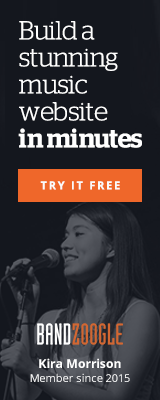 December 4, 2017
December 4, 2017 How To Advertise Your Music Using Google AdWords
This post was written by Lisa Occhino and originally appeared on the Bandzoogle Blog
You’ve probably tried boosting your posts on Facebook, and maybe you’ve even run a few ads on Instagram. But have you ever considered how powerful Google’s search network can be for advertising your music?
Optimizing your online presence for Google is super important, and there’s a lot you can do to increase organic search traffic to your band website. But in this article, we’re going to explore how to advertise your music using Google AdWords.
Although big companies pour thousands of dollars per month (and sometimes even per day) into AdWords campaigns, the great thing about the platform is that you can completely customize it for your own needs and budget, no matter how big or small.
Even if you invest just a few dollars a day, you can see how many people are shown your ads, how many people click through to your website, and which ads and keywords are outperforming the rest.
For example, let’s say you’re a local band looking to get booked for wedding or corporate gigs in your area. If you run an AdWords campaign with the right geo-targeting and keywords, you can essentially guarantee that you’re reaching people who are actively looking to book bands like yours. And the more relevant your ads are to your target audience, the less you actually end up paying per click.
Define your goal
First, ask yourself: What am I looking to get out of an AdWords campaign? Whether it’s selling tickets for a show, booking local gigs, or driving more traffic to your website to get email list signups, it helps enormously to have a specific goal in mind right from the start.
You’ll find that there are many different elements to experiment with as you go through the process of setting up a campaign, so don’t get frustrated if you don’t hit your goal the first time around. Sometimes, a small change can make a big difference in how effective your ads are.
How much does AdWords cost?
AdWords uses a cost-per-click (CPC) model, which means that you only get charged when someone actually clicks on your ad, no matter how many times it’s shown. You can set whatever daily budget you’re comfortable with, and you can rest assured that you’ll never spend more than that amount per day.
Your CPC is largely determined by how many other advertisers are bidding on the same keywords that you’ve selected. While keyword competition and maximum bids are both important factors, AdWords also takes quality and relevance into consideration — which means that better ads are rewarded with lower costs and better placement.
How to find relevant keywords
The keywords you select play a crucial role in the success of your ads, so it’s important to set aside some time for research before you dive into creating a campaign.
Put yourself in the shoes of your potential fans. What would you Google?
Google’s free Keyword Planner should be your first stop. You can use it to find out how often keywords are searched, how competitive they are, and even discover new keywords that could be effective for you. You can supplement your research with other free tools like Google Trends and Wordtracker.
As you research, start building a master list containing your most important keywords. You’ll need it to create your ads, so keep it handy!
We highly recommend that you read through our in-depth guide to keyword research (which also includes advice on what to do if search volume for your band is low), because the keywords you choose to target will make or break your campaign.
How to create an AdWords campaign from scratch
In this section, we’ll walk you through how to set up a simple Search Network ad.
There are other types of campaigns you can set up through AdWords, such as Display Network ads and YouTube video ads, but we suggest that you get comfortable with Search Network ads first, and then explore the other options later if you’d like.
Note: We’re using the new AdWords experience for this tutorial. Here’s how to switch if you have an existing AdWords account with the old experience.
1. If you don’t already have a Google AdWords account, head over to the AdWords homepage and click the “start now” button to sign up for free.
2. Once you’re logged in, click “campaigns,” then click the plus sign to create a new campaign.
3. You should now be on the “campaign type” screen. Click “search network,” then select your campaign goal.
4. After clicking “continue,” you’ll see the page where you enter all of your campaign settings.
To keep things simple for your first campaign, we recommend selecting “no” for “add display network” and keeping most of the default settings. Certainly feel free to specify different locations or languages based on where you are and the audience you’re targeting.
5. Enter your daily budget and your campaign start and end dates, and then click “save and continue.”
6. You should now be on the screen where you set up your ad groups. Using the master keyword list you built earlier, create two or three ad groups with sets of related keywords in each so that you can see what kind of searches are best for reaching your target audience.
Try not to go overboard with this — for now, stick with just a handful of relevant keywords for each ad group. You can always add more later if you’d like.
Important: Read up on keyword matching options (i.e., controlling the kind of searches that trigger your ads), because poorly matched keywords are one of the biggest money-wasting mistakes that beginners make with AdWords. If you have some flexibility with your spending, a broad-to-narrow strategy is the way to go. But if you’re on a really tight budget, your best bet is to start with narrower targeting and less traffic while you get the hang of AdWords, and then expand from there.
7. After you hit “save and continue” on your ad groups, you’ve reached the final step of the process: creating your ads. This is where you enter the headline, URL (which should be a landing page that’s highly relevant to the search), and description for your ad.
Google recommends creating at least three ads per ad group to see what messaging works for your potential fans. Here’s a complete list of best practices for search ads.
Pro tip: You’ll see a better click-through rate if you use keywords from your ad group in the ad headline itself.
8. Once you’ve finalized your ads and entered your billing information, you’re done with your campaign setup!
At this point, it’s a good idea to go back through the campaign and review everything you’ve entered to make sure it’s exactly what you want. You can make edits to your budget, ad groups, keywords, and ads by using the menu on the left side of the screen.
It might take a little time for for your ads to be reviewed, but once they’re approved, they’ll automatically run between the start and end dates you specified for your campaign.
Test and measure performance
As with all forms of digital advertising, running a successful AdWords campaign requires consistent testing, tracking, and tweaking to get the most bang for your buck.
Be patient for the first few days and allow the data to accumulate. In about a week, you should start to have an idea of which ads and keywords are performing better than others. Keep a close eye on them, and pause any ads or ad groups that are clearly not performing well at all.
If you’re seeing promising results after a couple of weeks, consider increasing your daily budget. If not, don’t panic — just continue testing different combinations of keywords and ad copy until you find your sweet spot.
It’s a good idea to log into AdWords at least once a week to see how your campaigns are doing, and make any tweaks if necessary. You can avoid wasting a lot of money if you regularly review the search terms that led to clicks on your ad and carefully build a negative keyword list.
If you’d like to gain a deeper understanding of the platform and start experimenting with other types of ads besides search ads, the AdWords Help Center is a great resource.
Lisa Occhino is the founder of SongwriterLink and the Director of Marketing & Communications at Soundfly. She’s also a pianist, award-winning songwriter, and graduate of Berklee College of Music.
 DIY,
DIY,  Promotion tagged
Promotion tagged  DIY,
DIY,  Google,
Google,  advertising,
advertising,  google adwords,
google adwords,  promotion
promotion 





Reader Comments